engine Hyundai Sonata Turbo 2011 Owner's Manual
[x] Cancel search | Manufacturer: HYUNDAI, Model Year: 2011, Model line: Sonata Turbo, Model: Hyundai Sonata Turbo 2011Pages: 390, PDF Size: 8.44 MB
Page 4 of 390
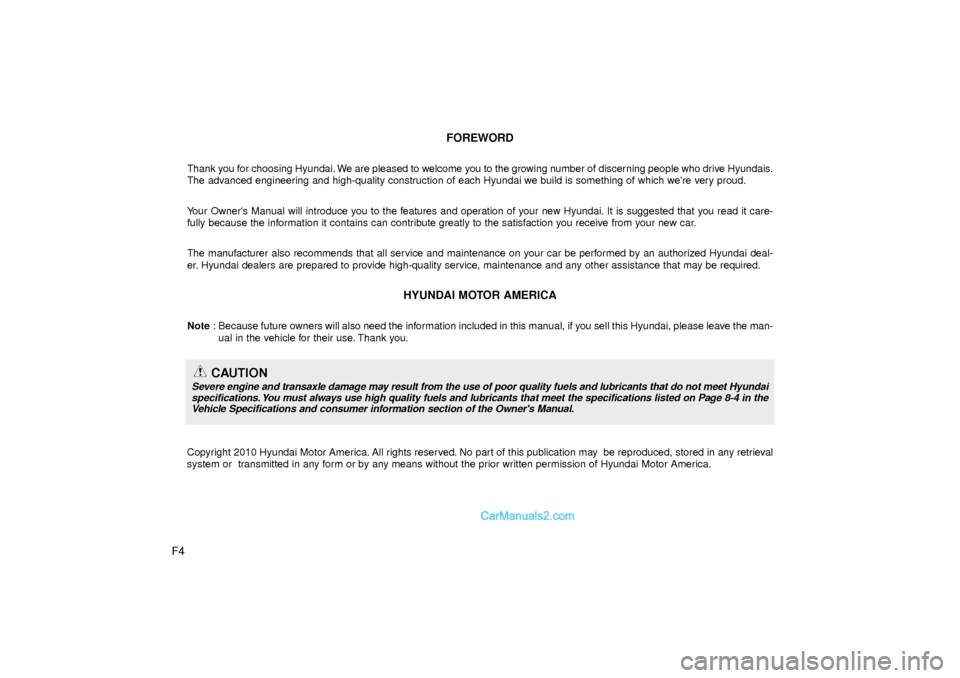
F4FOREWORD
Thank you for choosing Hyundai. We are pleased to welcome you to the growing number of discerning people who drive Hyundais.
The advanced engineering and high-quality construction of each Hyundai we build is something of which we're very proud.
Your Owner's Manual will introduce you to the features and operation of your new Hyundai. It is suggested that you read it care-
fully because the information it contains can contribute greatly to the satisfaction you receive from your new car.
The manufacturer also recommends that all service and maintenance on your car be performed by an authorized Hyundai deal-
er. Hyundai dealers are prepared to provide high-quality service, maintenance and any other assistance that may be required.
HYUNDAI MOTOR AMERICA
Note
: Because future owners will also need the information included in this manual, if you sell this Hyundai, please leave the man-
ual in the vehicle for their use. Thank you.
Copyright 2010 Hyundai Motor America. All rights reserved. No part of this publication may be reproduced, stored in any retrieva l
system or transmitted in any form or by any means without the prior written permission of Hyundai Motor America.
CAUTION
Severe engine and transaxle damage may result from the use of poor quality fuels and lubricants that do not meet Hyundai\
specifications. You must always use high quality fuels and lubricants that meet the specifications li\
sted on Page 8-4 in theVehicle Specifications and consumer information section of the Owner's Manual.
YF HMA foreword.qxp 4/13/2010 9:50 AM Page 4
Page 11 of 390
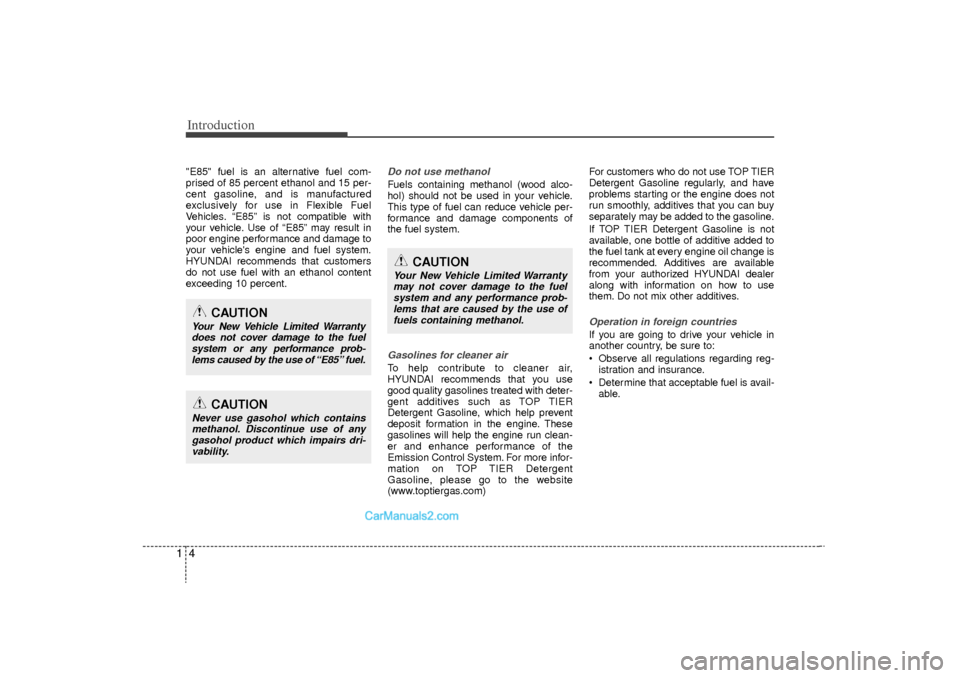
Introduction41"E85" fuel is an alternative fuel com-
prised of 85 percent ethanol and 15 per-
cent gasoline, and is manufactured
exclusively for use in Flexible Fuel
Vehicles. “E85” is not compatible with
your vehicle. Use of “E85” may result in
poor engine performance and damage to
your vehicle's engine and fuel system.
HYUNDAI recommends that customers
do not use fuel with an ethanol content
exceeding 10 percent.
Do not use methanolFuels containing methanol (wood alco-
hol) should not be used in your vehicle.
This type of fuel can reduce vehicle per-
formance and damage components of
the fuel system.Gasolines for cleaner airTo help contribute to cleaner air,
HYUNDAI recommends that you use
good quality gasolines treated with deter-
gent additives such as TOP TIER
Detergent Gasoline, which help prevent
deposit formation in the engine. These
gasolines will help the engine run clean-
er and enhance performance of the
Emission Control System. For more infor-
mation on TOP TIER Detergent
Gasoline, please go to the website
(www.toptiergas.com)For customers who do not use TOP TIER
Detergent Gasoline regularly, and have
problems starting or the engine does not
run smoothly, additives that you can buy
separately may be added to the gasoline.
If TOP TIER Detergent Gasoline is not
available, one bottle of additive added to
the fuel tank at every engine oil change is
recommended. Additives are available
from your authorized HYUNDAI dealer
along with information on how to use
them. Do not mix other additives.
Operation in foreign countriesIf you are going to drive your vehicle in
another country, be sure to:
Observe all regulations regarding reg-
istration and insurance.
Determine that acceptable fuel is avail- able.
CAUTION
Your New Vehicle Limited Warrantymay not cover damage to the fuelsystem and any performance prob- lems that are caused by the use offuels containing methanol.
CAUTION
Never use gasohol which containsmethanol. Discontinue use of any gasohol product which impairs dri-vability.
CAUTION
Your New Vehicle Limited Warrantydoes not cover damage to the fuelsystem or any performance prob- lems caused by the use of “E85” fuel.
YF HMA 1.qxp 8/24/2010 12:48 PM Page 4
Page 12 of 390
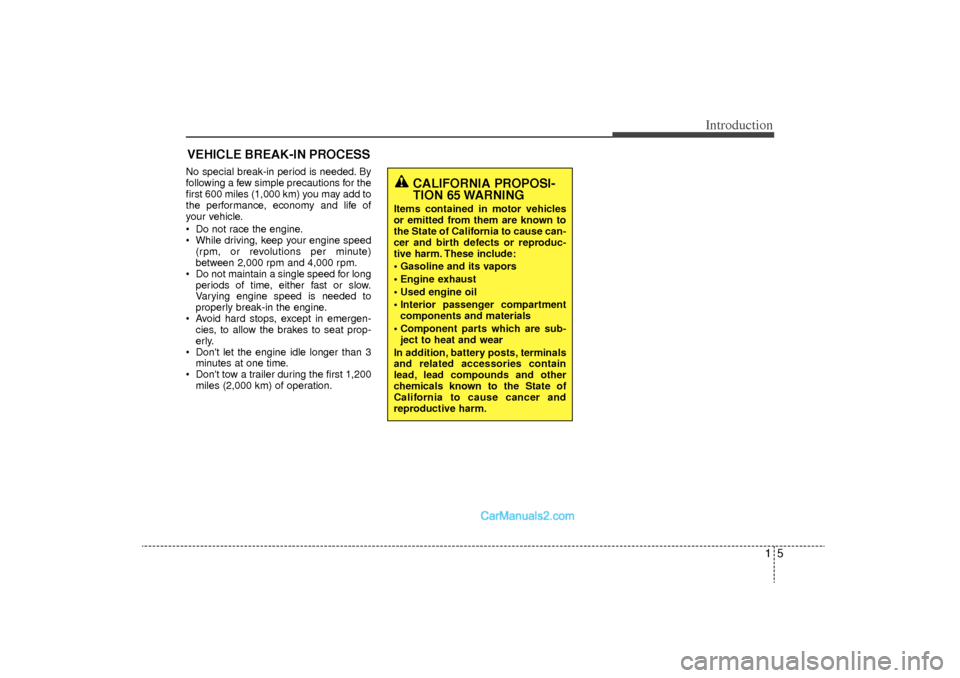
15
Introduction
No special break-in period is needed. By
following a few simple precautions for the
first 600 miles (1,000 km) you may add to
the performance, economy and life of
your vehicle.
Do not race the engine.
While driving, keep your engine speed(rpm, or revolutions per minute)
between 2,000 rpm and 4,000 rpm.
Do not maintain a single speed for long periods of time, either fast or slow.
Varying engine speed is needed to
properly break-in the engine.
Avoid hard stops, except in emergen- cies, to allow the brakes to seat prop-
erly.
Don't let the engine idle longer than 3 minutes at one time.
Don't tow a trailer during the first 1,200 miles (2,000 km) of operation.VEHICLE BREAK-IN PROCESS
CALIFORNIA PROPOSI-
TION 65 WARNING
Items contained in motor vehicles
or emitted from them are known to
the State of California to cause can-
cer and birth defects or reproduc-
tive harm. These include:
Gasoline and its vapors
Engine exhaust
Used engine oil
Interior passenger compartmentcomponents and materials
Component parts which are sub- ject to heat and wear
In addition, battery posts, terminals
and related accessories contain
lead, lead compounds and other
chemicals known to the State of
California to cause cancer and
reproductive harm.
YF HMA 1.qxp 8/24/2010 12:48 PM Page 5
Page 14 of 390
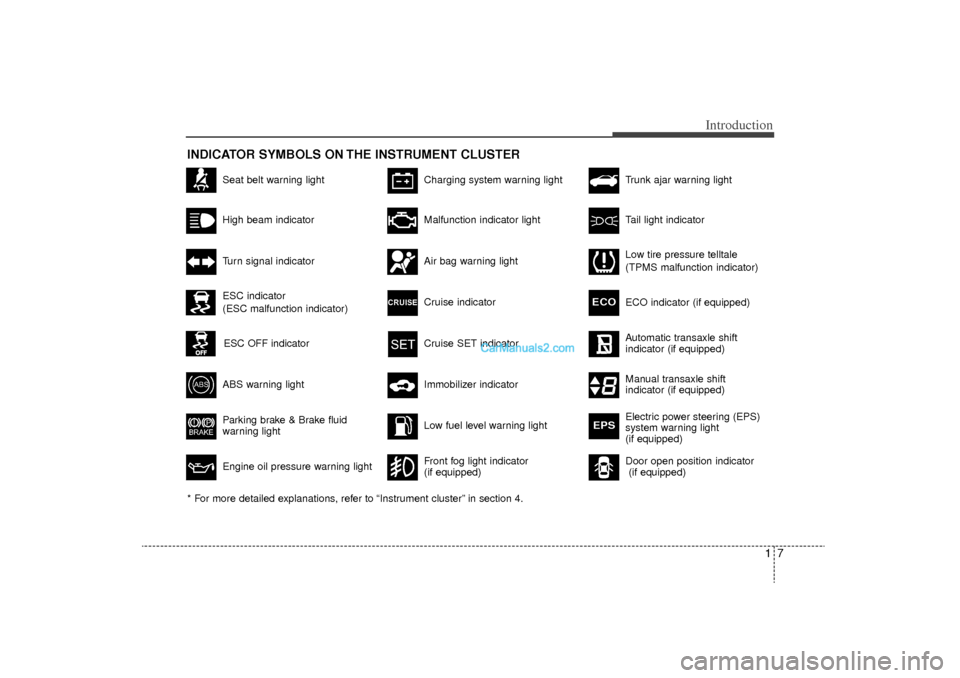
17
Introduction
INDICATOR SYMBOLS ON THE INSTRUMENT CLUSTER
Seat belt warning lightHigh beam indicatorTurn signal indicatorABS warning light Parking brake & Brake fluid
warning lightEngine oil pressure warning light
Malfunction indicator lightAir bag warning light Cruise indicatorCruise SET indicator Immobilizer indicator Low fuel level warning light
* For more detailed explanations, refer to “Instrument cluster” in section 4.Charging system warning light
Tail light indicator Trunk ajar warning light
Front fog light indicator
(if equipped)
Automatic transaxle shift
indicator (if equipped)Manual transaxle shift
indicator (if equipped)Door open position indicator (if equipped)
Low tire pressure telltale
(TPMS malfunction indicator)ECO indicator (if equipped)
ECO
Electric power steering (EPS)
system warning light
(if equipped)
EPS
ESC indicator
(ESC malfunction indicator)ESC OFF indicator
YF HMA 1.qxp 8/24/2010 12:48 PM Page 7
Page 15 of 390
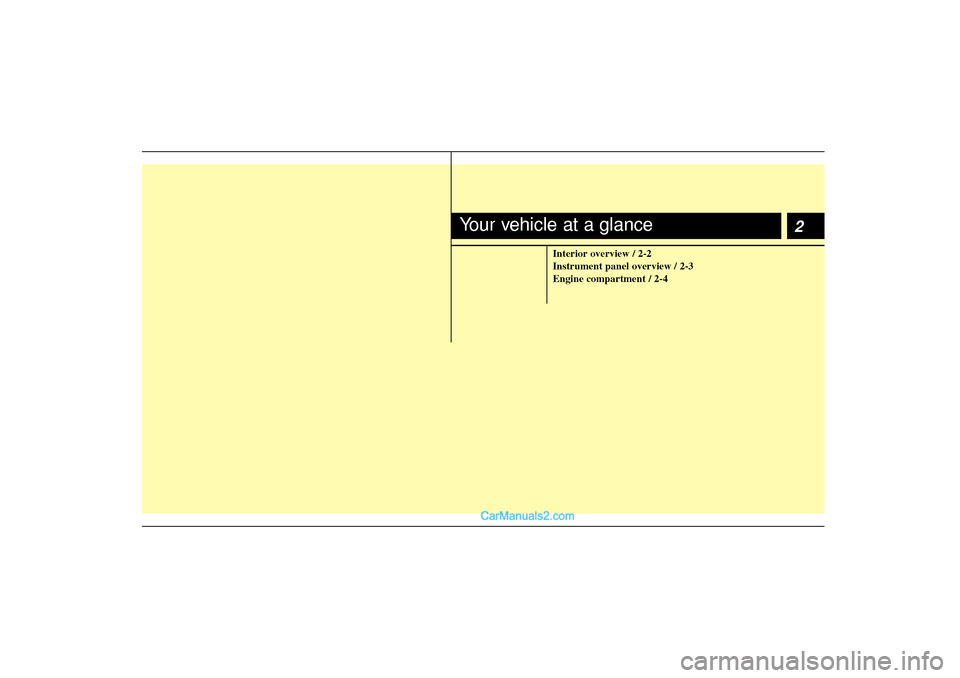
2
Interior overview / 2-2
Instrument panel overview / 2-3
Engine compartment / 2-4
Your vehicle at a glance
YF HMA 2.qxp 8/23/2010 2:17 PM Page 1
Page 17 of 390
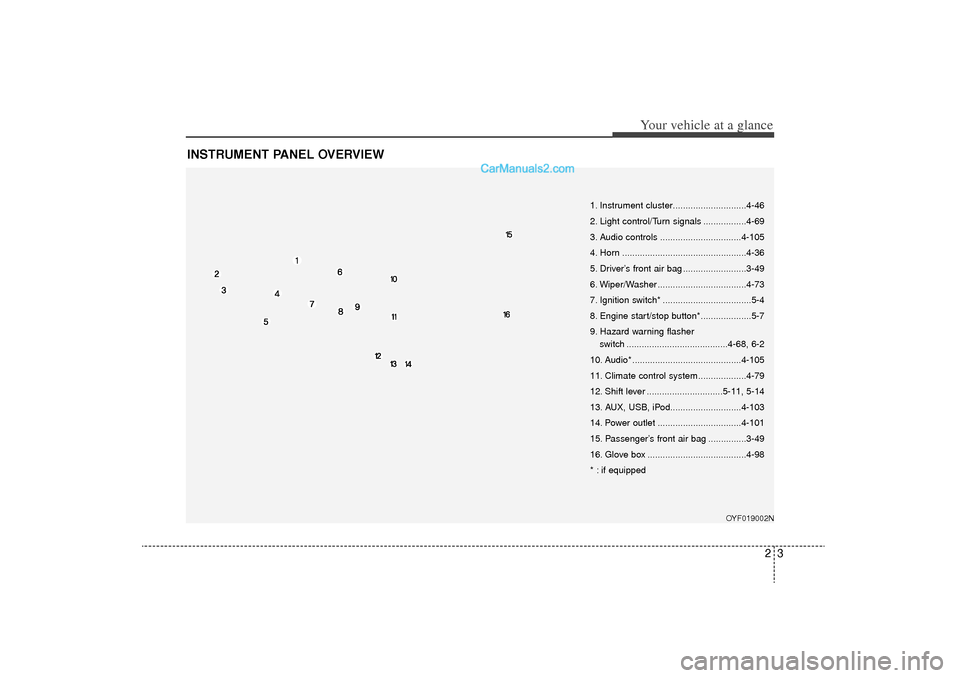
23
Your vehicle at a glance
INSTRUMENT PANEL OVERVIEW
OYF019002N
1. Instrument cluster.............................4-46
2. Light control/Turn signals .................4-69
3. Audio controls ................................4-105
4. Horn .................................................4-36
5. Driver’s front air bag .........................3-49
6. Wiper/Washer ...................................4-73
7. Ignition switch* ...................................5-4
8. Engine start/stop button*....................5-7
9. Hazard warning flasherswitch ........................................4-68, 6-2
10. Audio* ...........................................4-105
11. Climate control system ...................4-79
12. Shift lever ..............................5-11, 5-14
13. AUX, USB, iPod............................4-103
14. Power outlet .................................4-101
15. Passenger’s front air bag ...............3-49
16. Glove box .......................................4-98
* : if equipped
YF HMA 2.qxp 8/23/2010 2:18 PM Page 3
Page 18 of 390
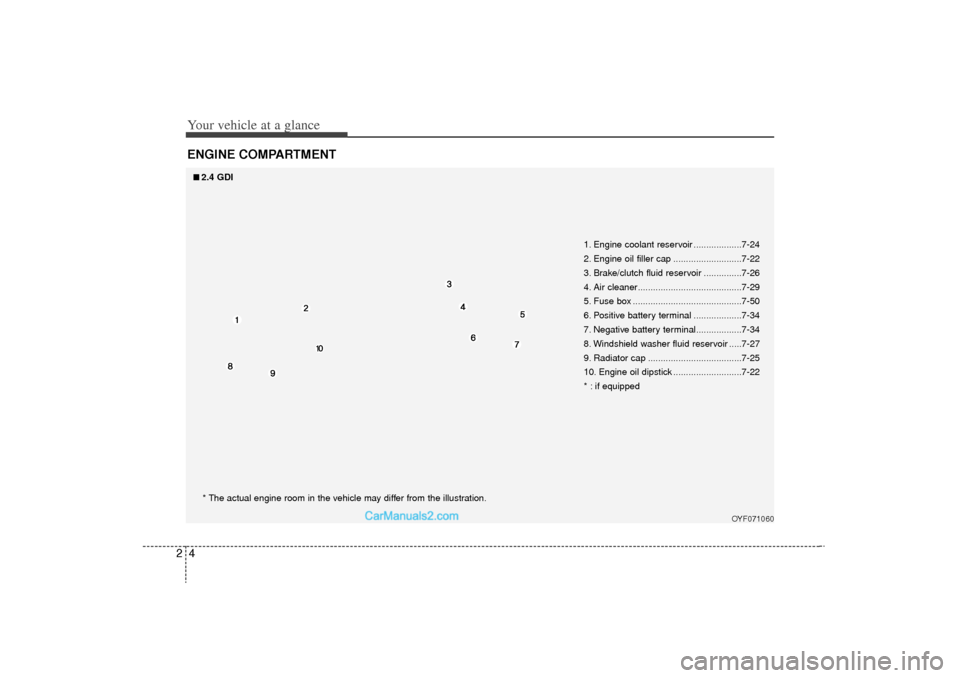
Your vehicle at a glance42ENGINE COMPARTMENT
OYF071060
* The actual engine room in the vehicle may differ from the illustration.1. Engine coolant reservoir ...................7-24
2. Engine oil filler cap ...........................7-22
3. Brake/clutch fluid reservoir ...............7-26
4. Air cleaner.........................................7-29
5. Fuse box ...........................................7-50
6. Positive battery terminal ...................7-34
7. Negative battery terminal..................7-34
8. Windshield washer fluid reservoir .....7-27
9. Radiator cap .....................................7-25
10. Engine oil dipstick ...........................7-22
* : if equipped■
■
2.4 GDI
YF HMA 2.qxp 8/23/2010 2:18 PM Page 4
Page 19 of 390
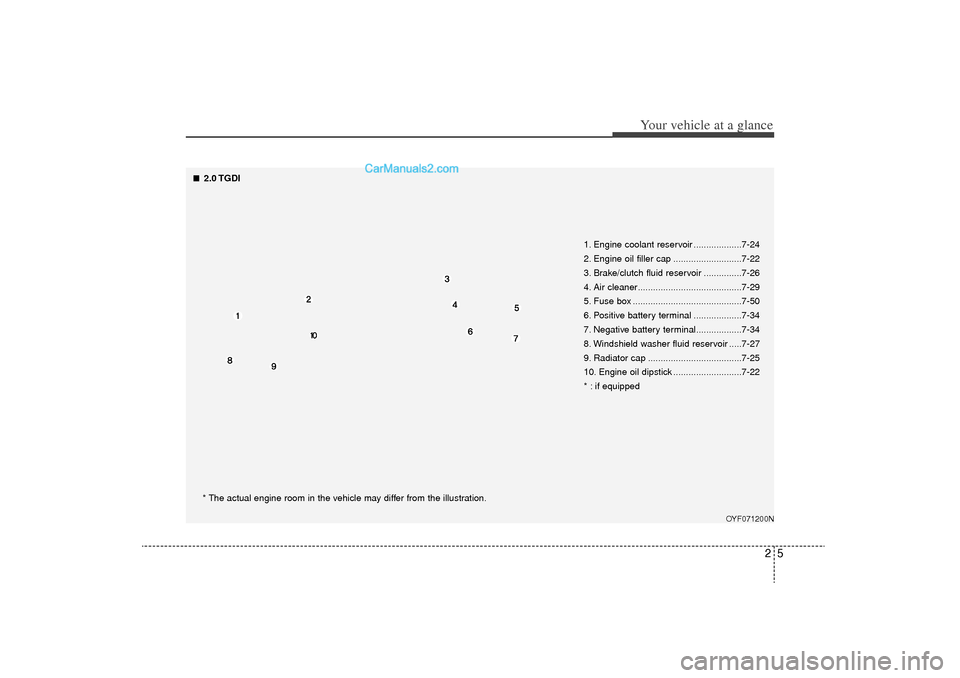
25
Your vehicle at a glance
OYF071200N
* The actual engine room in the vehicle may differ from the illustration.1. Engine coolant reservoir ...................7-24
2. Engine oil filler cap ...........................7-22
3. Brake/clutch fluid reservoir ...............7-26
4. Air cleaner.........................................7-29
5. Fuse box ...........................................7-50
6. Positive battery terminal ...................7-34
7. Negative battery terminal..................7-34
8. Windshield washer fluid reservoir .....7-27
9. Radiator cap .....................................7-25
10. Engine oil dipstick ...........................7-22
* : if equipped■
■
2.0 TGDI
YF HMA 2.qxp 8/23/2010 2:18 PM Page 5
Page 25 of 390
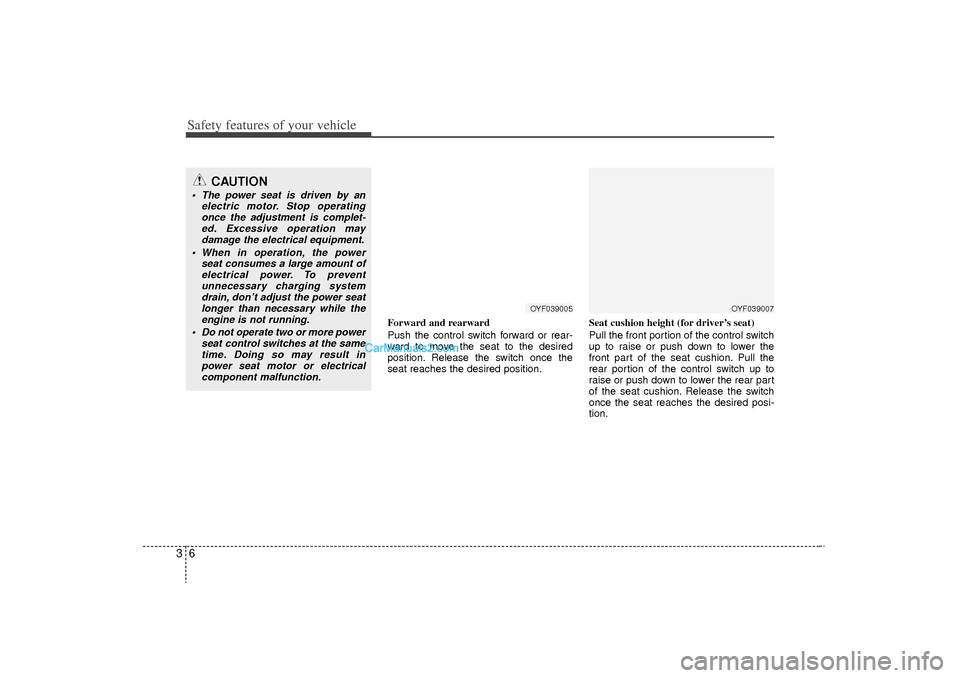
Safety features of your vehicle63
Forward and rearward
Push the control switch forward or rear-
ward to move the seat to the desired
position. Release the switch once the
seat reaches the desired position.Seat cushion height (for driver’s seat)
Pull the front portion of the control switch
up to raise or push down to lower the
front part of the seat cushion. Pull the
rear portion of the control switch up to
raise or push down to lower the rear part
of the seat cushion. Release the switch
once the seat reaches the desired posi-
tion.
CAUTION
The power seat is driven by an
electric motor. Stop operatingonce the adjustment is complet-ed. Excessive operation maydamage the electrical equipment.
When in operation, the power seat consumes a large amount ofelectrical power. To preventunnecessary charging systemdrain, don’t adjust the power seat longer than necessary while theengine is not running.
Do not operate two or more power seat control switches at the sametime. Doing so may result inpower seat motor or electrical component malfunction.
OYF039005
OYF039007
YF HMA 3.qxp 8/20/2010 4:22 PM Page 6
Page 35 of 390
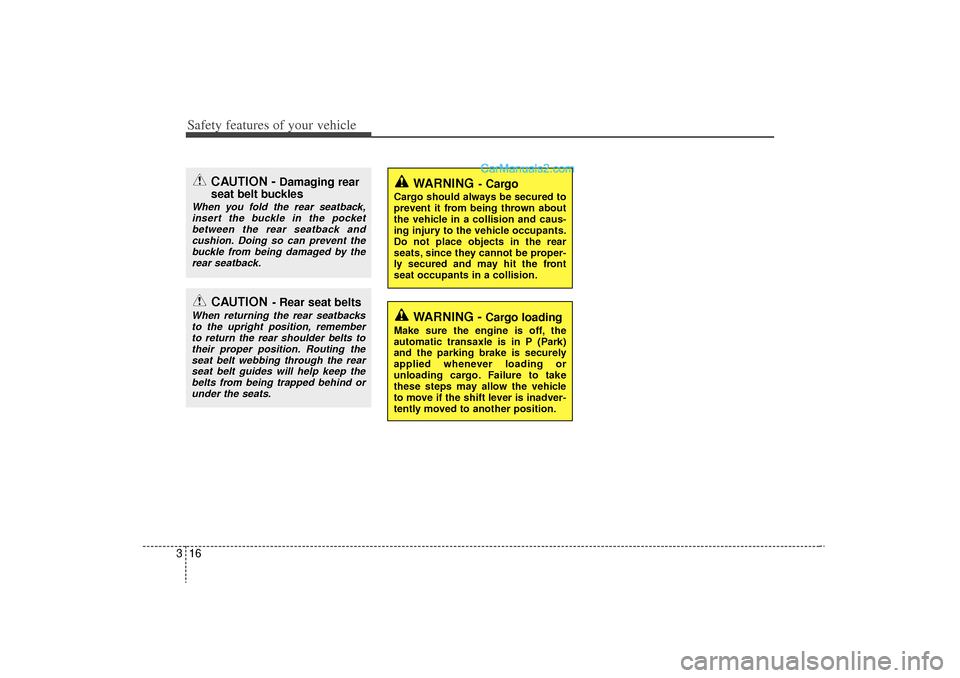
Safety features of your vehicle16
3
WARNING
- Cargo
Cargo should always be secured to
prevent it from being thrown about
the vehicle in a collision and caus-
ing injury to the vehicle occupants.
Do not place objects in the rear
seats, since they cannot be proper-
ly secured and may hit the front
seat occupants in a collision.
CAUTION
- Rear seat belts
When returning the rear seatbacks
to the upright position, remember to return the rear shoulder belts totheir proper position. Routing theseat belt webbing through the rearseat belt guides will help keep the belts from being trapped behind orunder the seats.
CAUTION -
Damaging rear
seat belt buckles
When you fold the rear seatback,
insert the buckle in the pocketbetween the rear seatback andcushion. Doing so can prevent thebuckle from being damaged by the rear seatback.
WARNING -
Cargo loading
Make sure the engine is off, the
automatic transaxle is in P (Park)
and the parking brake is securely
applied whenever loading or
unloading cargo. Failure to take
these steps may allow the vehicle
to move if the shift lever is inadver-
tently moved to another position.
YF HMA 3.qxp 8/20/2010 4:24 PM Page 16